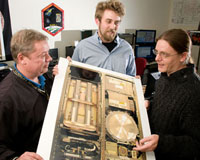 |
Hawthorne, CA (SPX) Mar 31, 2010 Space Exploration Technologies (SpaceX) announces the successful activation of its new Dragon spacecraft communication hardware aboard the International Space Station (ISS) during a series of operations conducted in January and March. Dubbed the Commercial Orbital Transportation Services (COTS) Ultra High Frequency (UHF) Communication Unit, the new system will allow ISS crewmembers to monitor and command approaching or departing Dragon spacecraft during cargo delivery missions to the orbiting laboratory. Space Shuttle Atlantis delivered the system hardware to the ISS during mission STS-129 in November 2009. The on-orbit checkout began January 25, 2010, when astronaut Jeff Williams, ISS Expedition 22 Commander, worked with ground-based team members at SpaceX headquarters and ISS mission control in Houston to power-up and check out the new system. On March 11, SpaceX and NASA Houston performed an additional series of tests, using the new system to send communications between the ISS and the NASA Dryden ground station. This provided a baseline of the radio frequency performance and confirmed the first set of antennas performed as expected and is ready for mission operations. Additional testing is expected for a second set of antennas as well as ongoing verification of the overall system. The tests employed live video and telemetry links from the ISS to verify the hardware's functionality, broadcast and reception signal strengths, and the system's stability over long-duration operations. "The success of this series of tests speaks to our close collaboration with NASA as well as the SpaceX process that allowed the rapid development of this new hardware," said Marco Villa, SpaceX Mission Operations Manager. "Furthermore, the January tests marked the first official joint operations between SpaceX Mission Control in California, and NASA Mission Control in Houston. Everything went smoothly, and we eagerly anticipate the upcoming Dragon visits to the ISS." Developed by SpaceX under a NASA Space Act Agreement, the new system allows for communication between the ISS and SpaceX's Dragon spacecraft while in the vicinity of the ISS. Its design leverages the abilities of the ISS communication systems, providing data exchange with ground-based mission control. Designed from the beginning to transport crew, SpaceX's Falcon 9 and Dragon spacecraft were selected by NASA to transport cargo to and from the ISS starting in 2011. The $1.6B contract represents 12 flights for a minimum of 20 tons to and from the ISS. The first demonstration flights under the COTS program are scheduled for 2010, following the inaugural launch of SpaceX's Falcon 9 rocket.
Share This Article With Planet Earth
Related Links Space Exploration Technologies (SpaceX) Station at NASA Station and More at Roscosmos S.P. Korolev RSC Energia Watch NASA TV via Space.TV Space Station News at Space-Travel.Com
 UA Engineers First To Use Space Station Test Bed
UA Engineers First To Use Space Station Test BedTucson AZ (SPX) Mar 26, 2010 When astronauts aboard the Space Shuttle Endeavor docked with the International Space Station on Feb. 10, more than 200 miles above the Atlantic west of Portugal, part of their mission was to collect a sample from an experiment conducted by University of Arizona College of Engineering researchers. The small ingot of aluminum-silicon alloy was the first material sample supporting U.S. resea ... read more |
|
| The content herein, unless otherwise known to be public domain, are Copyright 1995-2010 - SpaceDaily. AFP and UPI Wire Stories are copyright Agence France-Presse and United Press International. ESA Portal Reports are copyright European Space Agency. All NASA sourced material is public domain. Additional copyrights may apply in whole or part to other bona fide parties. Advertising does not imply endorsement,agreement or approval of any opinions, statements or information provided by SpaceDaily on any Web page published or hosted by SpaceDaily. Privacy Statement |